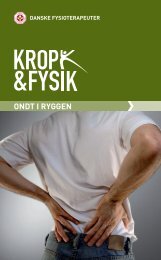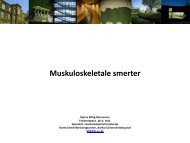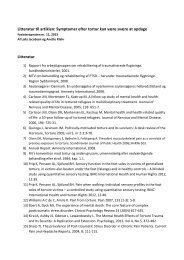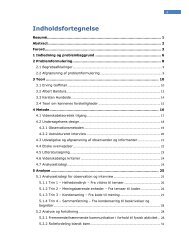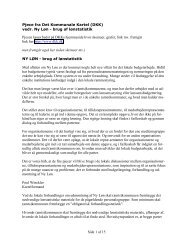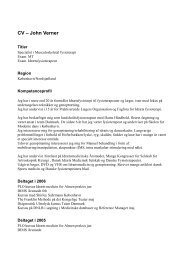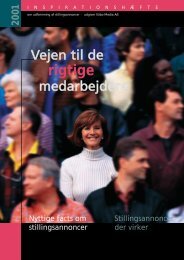Ulla Werlauff Methods to assess physical functioning - Danske ...
Ulla Werlauff Methods to assess physical functioning - Danske ...
Ulla Werlauff Methods to assess physical functioning - Danske ...
Create successful ePaper yourself
Turn your PDF publications into a flip-book with our unique Google optimized e-Paper software.
Assessments at impairment level<br />
Gender and ages were recorded and reported in all studies. Influence of gender was calculated in<br />
study IV. In study I, the patients’ age was used as cut points <strong>to</strong> describe characteristics in different<br />
age groups and <strong>to</strong> calculate differences among young and old patients.<br />
Antropometrics (study I)<br />
Since all patients in study I were non-ambulant, height in meters was measured as full length of arm<br />
span between finger tips by a flexible measuring tape [Hepper 1965, Miller 1992]. Weight was<br />
recorded in kilos using a scale for lifts.<br />
Measurement of dynamic muscle strength (study I, II, III)<br />
Muscle strength was tested by manual muscle testing (MMT) based on the Medical Research<br />
Council (MRC) method [1943]. MRC scores 0-5 were modified <strong>to</strong> a 0-10 score <strong>to</strong> make the scale<br />
more sensitive according <strong>to</strong> the modification of Brooke et al. [1981]. Manual muscle testing of 38<br />
muscle groups of the whole body was measured in study I, and based on our findings in this study,<br />
we decided <strong>to</strong> focus on muscle strength of the upper limbs in study II, in which nine muscle groups<br />
were measured. In study III, we calculated the change over time in seven muscle groups of the<br />
upper limbs in patients with SMA II and III, and for SMA III also in six muscle groups of the lower<br />
limb. All muscle tests were performed bilaterally. MRC score was calculated as percentage of<br />
maximal possible score by the fraction used by Scott et al [1982]: MRC% = sum of graded scores x<br />
100/ (number of muscle tested x 10).<br />
The reliability of the manual muscle test increases when performed by a clinically experienced<br />
evalua<strong>to</strong>r and when followed by a standardized pro<strong>to</strong>col [Cuthberth 2007, Escolar 2001]. Inter-rater<br />
reliability is also improved when testing weak muscles and when tested by a limited number of<br />
experienced evalua<strong>to</strong>rs [Kleyweg 1991, Florence 1992, Mahony 2009].<br />
These criteria were all met in our studies: Patients with SMA II have very limited muscle strength<br />
ranging from 1 <strong>to</strong> 3 on the MRC scale. All <strong>assess</strong>ments were performed by one of four trained and<br />
clinically experienced evalua<strong>to</strong>r and training sessions were arranged over the years <strong>to</strong> ensure<br />
consistency and agreement among evalua<strong>to</strong>rs. At the last training session, agreement among four<br />
24




